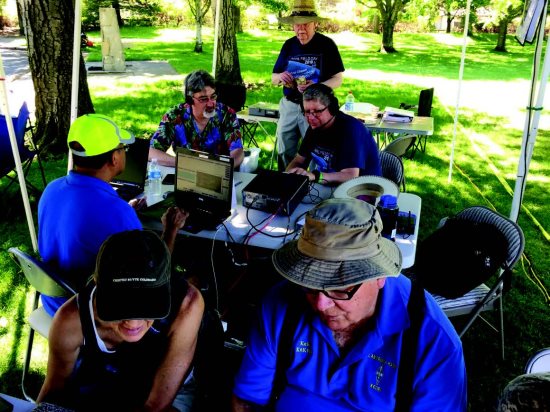| | Published July 11th , 2018
| Having a field day at Field Day
| | | By Cathy Dausman |  | | Clark, foreground, left learns to operate a single sideband UHF radio with lifelong amateur radio operator Keith Riley (foreground, right), and other members of LARIG. Photo Cathy Dausman |
Two dozen people started a conversation in Moraga Commons Park on a recent Saturday, kept at it for eight hours straight, and they still finished early.
 It was amateur radio Field Day and the Lamorinda Area Radio Interest Group joined forces with thousands of other amateur radio operators across the U.S. during a 24-hour demonstration and contest. The amateurs sent messages across a high frequency radio bandwidth via Morse Code, single sideband voice and digital radio.
It was amateur radio Field Day and the Lamorinda Area Radio Interest Group joined forces with thousands of other amateur radio operators across the U.S. during a 24-hour demonstration and contest. The amateurs sent messages across a high frequency radio bandwidth via Morse Code, single sideband voice and digital radio.
 Outgoing messages were short and sweet. "C-Q Field Day, this is K6ORI," the chant began. "C-Q" is shorthand for "attention all stations" and K6ORI is the LARIG club call sign.
Outgoing messages were short and sweet. "C-Q Field Day, this is K6ORI," the chant began. "C-Q" is shorthand for "attention all stations" and K6ORI is the LARIG club call sign.
 Return messages were equally brief: "K6ORI, this is WA7LO, we are 3-alpha, Oscar Romeo." Three-alpha Oscar Romeo was shorthand for number of radios a station operated, its use of alternative power and its geographic location.
Return messages were equally brief: "K6ORI, this is WA7LO, we are 3-alpha, Oscar Romeo." Three-alpha Oscar Romeo was shorthand for number of radios a station operated, its use of alternative power and its geographic location.
 The underlying message, however, was perhaps most important: that amateur radio works when electrical power is out or cell towers are down.
The underlying message, however, was perhaps most important: that amateur radio works when electrical power is out or cell towers are down.
 Cristy Clark is a new amateur radio operator (sometimes called a "ham") who earned her Technician license in February. She recalls her first exposure to the hobby was as an Acalanes High School student. Clark found that club inaccessible, in her words, because the club was all-male and met off-campus. Recently a neighbor who is a ham encouraged her to earn a license. After passing her test, Clark started using a handheld radio but found she was eager to learn more.
Cristy Clark is a new amateur radio operator (sometimes called a "ham") who earned her Technician license in February. She recalls her first exposure to the hobby was as an Acalanes High School student. Clark found that club inaccessible, in her words, because the club was all-male and met off-campus. Recently a neighbor who is a ham encouraged her to earn a license. After passing her test, Clark started using a handheld radio but found she was eager to learn more.
 "Field Day is such a friendly time," Clark said. "There is so much to learn about antennas, radios and listening, even if you don't have a license." Club members were quick to point out that anyone can participate in Field Day under the guidance of a licensed amateur. When space opened up at one radio station, Clark sat down to listen before finally diving in to make her first contact to a participant stationed in Oregon. She was amazed at the level of concentration it took to decipher a conversation on single sideband radio. Fortunately, "they're not asking much of you" in the way of reply, Clark said. She found so much to learn, about antennas, radios, and even the skill of listening for voices in the static.
"Field Day is such a friendly time," Clark said. "There is so much to learn about antennas, radios and listening, even if you don't have a license." Club members were quick to point out that anyone can participate in Field Day under the guidance of a licensed amateur. When space opened up at one radio station, Clark sat down to listen before finally diving in to make her first contact to a participant stationed in Oregon. She was amazed at the level of concentration it took to decipher a conversation on single sideband radio. Fortunately, "they're not asking much of you" in the way of reply, Clark said. She found so much to learn, about antennas, radios, and even the skill of listening for voices in the static.
 Since being licensed, Clark says people express surprise that she enjoys an interest outside many women's interest or skill set: "You're involved in what?" they ask. Yet unlike the golf lessons she took before discovering she hated golf, Clark is sticking with amateur radio. She sees its value as an emergency communication method and Field Day as good disaster preparedness training.
Since being licensed, Clark says people express surprise that she enjoys an interest outside many women's interest or skill set: "You're involved in what?" they ask. Yet unlike the golf lessons she took before discovering she hated golf, Clark is sticking with amateur radio. She sees its value as an emergency communication method and Field Day as good disaster preparedness training.
 You don't have to be an electrical engineer to enjoy the hobby, she said.
You don't have to be an electrical engineer to enjoy the hobby, she said.


|
| | | | | | | | | | | | |



